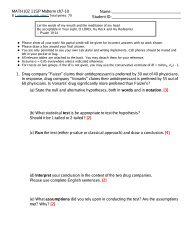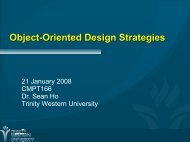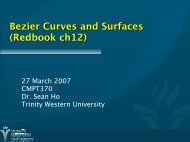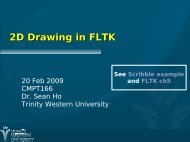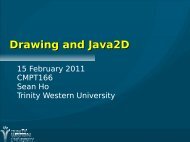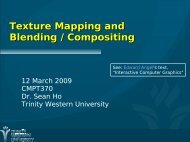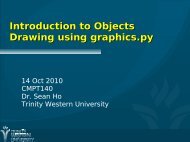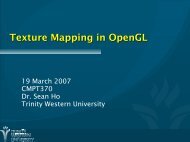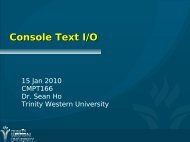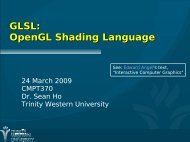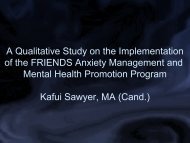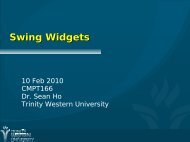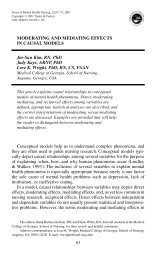Probability
Probability
Probability
- No tags were found...
Create successful ePaper yourself
Turn your PDF publications into a flip-book with our unique Google optimized e-Paper software.
Ch4: <strong>Probability</strong>20 Sep 2011BUSI275Dr. Sean Ho● HW2 due Thu 10pm
z-scores Describes a value's position relative to themean, in units of standard deviations:● z = (x – μ)/σ e.g., you got a score of 35 on a test:is this good or bad? Depends on the mean, SD:● μ=30, σ=10: then z = +0.5: pretty good● μ=50, σ=5: then z = -3: really bad!BUSI275: <strong>Probability</strong> 20 Sep 20113
<strong>Probability</strong> Chance of a particular event happening e.g., in a sample of 1000 people,say 150 will buy your product:● ⇒ the probability that a random person fromthe sample will buy your product is 15%● Experiment: pick a random person (1 trial)● Possible outcomes: {“buy”, “no buy”}● Sample space: {“buy”, “no buy”}● Event of interest: A = {“buy”}● P(A) = 15%BUSI275: <strong>Probability</strong> 20 Sep 20114
Event trees Experiment: pick 3 people from the group Outcomes for a single trial: {“buy”, “no buy”} Sample space: {BBB, BBN, BNB, BNN, NBB, …}buy15%no buy85%buy15%no buy85%buy15%no buy85%buy15%no buy85%buy15%no buy85%buy15%no buy85%buy15%no buy85%P(BNB)= (.15)(.85)(.15) Event: A = {at least 2 people buy}: P(A) = ?BUSI275: <strong>Probability</strong> 20 Sep 20115
Venn diagrams Box represents whole sample space Circles represent events (subsets) within SS e.g., for a single trial:P(SS) = 1P(A) = .35ABP(B) = .15● A = “clicks on ad”● B = “buys product”BUSI275: <strong>Probability</strong> 20 Sep 20116
Venn: set theory Complement: A= “does not click ad”● P(A) = 1 - P(A)AA Intersection: A ∩ B= “clicks ad and buys” Union: A ∪ B= “either clicksad or buys”A ∩ BA ∪ BBUSI275: <strong>Probability</strong> 20 Sep 20117
Addition rule: A ∪ BP(A ∪ B)=P(A)+P(B)-P(A ∩ B)BUSI275: <strong>Probability</strong> 20 Sep 20118
Addition rule: example 35% of the focus group clicks on ad:● P(?) = .35 15% of the group buys product:● P(?) = .15 45% are “engaged” with the company:either click ad or buy product:● P(?) = .45 ⇒ What fraction of the focus groupbuys the product through the ad?● P(A ∪ B) = P(A) + P(B) – P(A ∩ B)? = ? + ? - ?BUSI275: <strong>Probability</strong> 20 Sep 20119
Mutual exclusivity Two events A and B are mutually exclusive ifthe intersection is null: P(A ∩ B) = 0● i.e., an outcome cannot satisfy both A and Bsimultaneously e.g., A = male, B = female e.g., A = born in Alberta, B = born in BC If A and B are mutually exclusive, then theaddition rule simplifies to:● P(A ∪ B) = P(A) + P(B)BUSI275: <strong>Probability</strong> 20 Sep 2011 10
Yep!BUSI275: <strong>Probability</strong> 20 Sep 2011 11
Conditional probability P(A|B): probability of A given B● “Narrows” the sample space to B P(buy) might be pretty small● Especially if nobody's heard of us P(buy | likes ad) could be much bigger● If the ad is effective: conversion rate Bayes' Theorem (rule): P(A|B) = P(A ∩ B) / P(B)BUSI275: <strong>Probability</strong> 20 Sep 2011 12
Bayes' Theorem: example Let: A = likes our adB = buys our product 40% of the focus group likes our ad● P(?) = .40 Of those who like our ad, 10% buy our product(i.e., 10% conversion rate)● P(?) = .10 ⇒ What fraction of the focus group buys ourproduct?● P(B | A) = P(A ∩ B) / P(A)? = ? / ?BUSI275: <strong>Probability</strong> 20 Sep 2011 13
Statistical independence Two events A and B are independent when:● P(A|B) = P(A), or equivalently, P(B|A) = P(B)● One event being true does not change theprobability of the other event happening e.g., A = wears socks, B = has blue eyes● P(wearing socks) is the same regardless ofwhether the person has blue eyes e.g., A = first person buys our product,B = next (random) person buys our product● Assumes customers don't talk to each other Would these be independent?● A = likes our ad, B = buys our productBUSI275: <strong>Probability</strong> 20 Sep 2011 14
Indep. vs. mutual exclusivity A = likes our ad, B = buys our product But what if someone says:● “Just because someone doesn't like our ad,doesn't mean that they can't still buy ourproduct – just because event A is truedoesn't mean that event B is impossible.” Is this a statement about independence ormutual exclusivity?BUSI275: <strong>Probability</strong> 20 Sep 2011 15
Independence and Bayes' rule Recall Bayes: P(A|B) = P(A ∩ B) / P(B) Rewrite this as:● P(A ∩ B) = P(A|B) P(B) Now, if we also know that A and B arestatistically independent, then P(A|B) = P(A), so● P(A ∩ B) = P(A) P(B) P(both customers buy) =P(cust1 buys) P(cust2 buys)Cust1∩Cust2BUSI275: <strong>Probability</strong> 20 Sep 2011 16
TODO HW2 (ch2-3): due Thu 22 at 10pm● Remember to format as a document!● HWs are to be individual work Get to know your classmates and form teams● Email me when you know your team● You can come up with a good name, too Discuss topics/variables you are interested in● Find existing data, or gather your own?BUSI275: <strong>Probability</strong> 20 Sep 2011 17



